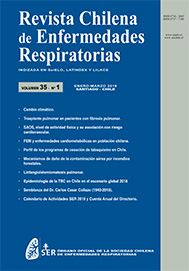Current profile of smoking cessation programs in Chile
##plugins.themes.bootstrap3.article.main##
Abstract
Introduction: In Chile, the prevalence of smoking is close to 40%. At present, even though smoking cessation treatments are cost-effective, only 14% of the population has access to them. The objective of this review is to describe the current evidence that exists in Chile in relation to smoking cessation programs. Methodology: A literature review was made in the Scielo and Pubmed databases. The inclusion criteria were articles from 2009 to 2015 that presented information about smoking cessation programs. Four studies were selected. We analyzed the design of cessation therapy programs, success rates, follow-up and the professionals who participated. Results: Three programs were found in the public system and one in a private clinic. The success rates were similar in three of them, ranging from 37% at 12 months and 48% in another study, and 34% at 6 months, and another group that had only 14% success at one year. All carried out follow-ups until the year of completion of the treatment, and the professionals involved in the programs were physician, psychologist and nurse, adding the kinesiologists in one. Conclusions: At the national level, information on smoking cessation programs is currently scarce. The design and methodology of programs were similar among studies, but there was no consensus at the national level as a clinical guide for the treatment of smoking, so it is necessary to develop them in order to implement these programs in different health institutions in our country.
##plugins.themes.bootstrap3.article.details##
Smoking, smoking cessation, tobacco smoking, cost-benefit analysis

This work is licensed under a Creative Commons Attribution-NonCommercial 4.0 International License.







